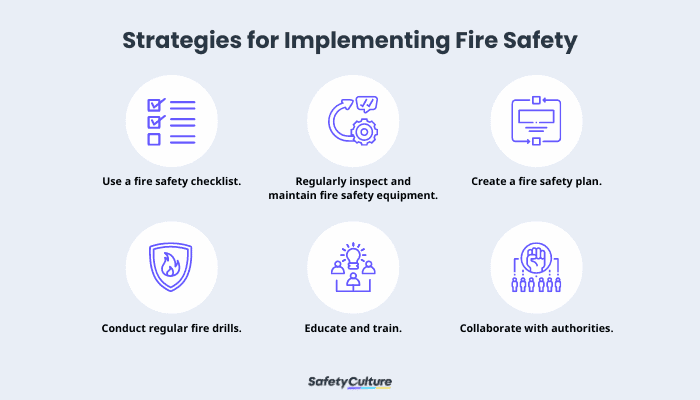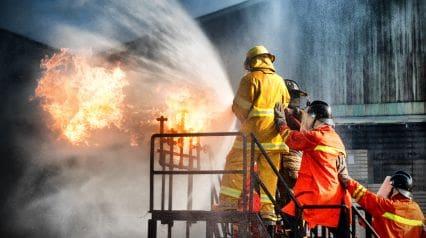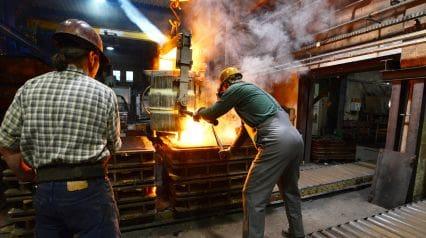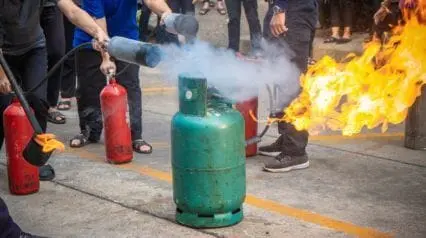What is Fire Safety?
Fire safety refers to the set of precautions, procedures, and measures taken to prevent fires, minimize the risk of fire-related accidents, and ensure the safety of individuals and property in the event of a fire. It involves a combination of awareness, preparedness, and proper safety practices to prevent fires from occurring and mitigate their impact if they do happen.
Importance
According to the US National Safety Council (NSC), the leading causes of home fires and injuries are cooking and heating. Thus, fire safety at home should be prioritized by practicing safety tips and protocols when using electrical appliances, cooking equipment, and others that may be fire hazards.
In addition, 2021 data from the US Fire Administration states that 116,500 non-residential building fires led to 1,025 injuries and 115 deaths. This is just one reason to implement fire safety in the workplace and mitigate the negative business impacts of fire-related incidents.
Moreover, fire safety is of paramount importance for the following reasons:
- Preserving life – Implementing measures helps protect individuals from harm and ensures their well-being.
- Protecting property – By following fire safety protocols, there’s minimal risk of property loss and destruction, potentially saving valuable assets and investments.
- Preventing financial losses – Adequate measures reduce the risk of fire-related damages, avoiding financial burdens associated with property damage, repairs, and insurance claims.
- Safeguarding the environment – Since fires can release toxic gases and pollutants and destroy natural habitats, fire safety practices can prevent such incidents and minimize harm to the environment.
- Ensuring business continuity – By safeguarding the workplace against fires, businesses can protect their employees, maintain productivity, and avoid costly downtime.
- Complying with regulations – Many jurisdictions have specific codes and regulations that must be followed. Adhering to these ensures legal compliance and helps avoid penalties or legal consequences.
- Promoting public safety – By prioritizing fire safety, communities can create a safer environment for everyone, reducing the overall risk of fire-related accidents and emergencies.
Standards and Regulations
Property owners, managers, and occupants must be familiar with the applicable standards and regulations in their jurisdiction. Compliance helps create a safer environment, reduces the risk of fires, and ensures the protection of lives and property.
Here are some examples of fire safety agencies and codes in different countries:
- United States
- United Kingdom
- England and Wales – Regulatory Reform (Fire Safety) Order 2005 (FSO)
- Health and Safety Executive (HSE)
- Australia
What are the Different Stages of a Fire?
To effectively carry out safety steps and protocols, you must be familiar with the four main phases of fire and what you can do during each stage. Here’s an overview:
- Incipient stage – The fire is small and localized at this stage, often limited to the materials or area of origin, and smoke production is usually minimal. If detected and addressed promptly, fires in the incipient stage can be easily extinguished.
- Growth stage – The flames become larger, and the fire starts to intensify as it consumes more fuel and generates more heat. Hence, it’s essential to take immediate action to control its spread and prevent it from reaching the fully developed stage.
- Fully developed stage – At this most dangerous and destructive phase of a fire, structural elements may be compromised, and there is a high risk of flashover (a sudden ignition of combustible gases and materials in the environment). Firefighting efforts should prioritize evacuation during this stage.
- Decay stage – The flames start to weaken, and the heat output and smoke production decrease. However, pockets of heat and hidden fire may still exist, making it important to fully extinguish the fire and ensure it does not reignite.
Fire Hazards to Look Out For
Apart from being aware of the various stages of a fire, it’s also crucial to know the fire hazards to look out for. This can help organizations and individuals take proactive measures and create an effective fire safety system.
The following are some common examples of fire hazards in residential, workplace, or public settings:
- Electrical hazards – faulty wiring, overloaded circuits, damaged electrical cords, and malfunctioning electrical equipment
- Cooking-related hazards – grease buildup, unattended cooking, and misuse of cooking appliances
- Heating sources – improper use of heating devices such as portable heaters, fireplaces, and wood-burning stoves
- Flammable liquids and chemicals – gasoline, paint thinners, and solvents
- Smoking – careless disposal of cigarette butts and smoking materials
- Open flames – unattended candles, incense, and open flames
- Flammable materials – paper, cardboard, textiles, and flammable gasses
Improve your EHS Management
Cultivate a safe working environment and streamline compliance with our EHS solutions.
Explore nowFire Safety Strategies

Strategies for Implementing Fire Safety
Implementing effective fire safety tips and strategies is crucial to minimize the risk of fires and ensure the safety of individuals and properties. Here are some steps you can take:
- Use a fire safety checklist — A checklist can help you systematically assess and address potential fire hazards within your premises.
- Regularly inspect and maintain fire safety equipment — It’s essential to have good working fire safety equipment at all times in case of an emergency. Common equipment most establishments have for this include the following:
- Fire doors
- Fire extinguishers (of different classes)
- Smoke detectors and alarms
- Sprinkler systems
- Emergency lights
- Fire escape ladders
- Fire-resistant clothing and gear
- Create a fire safety plan — Develop a thorough and easy-to-communicate fire safety and emergency response plan that includes detailed evacuation routes, clearly marked emergency exits, and designated assembly points.
- Conduct fire drills — Regular fire drills help evaluate the effectiveness of your procedures and identify points for improvement.
- Educate and train — Effective and regular fire safety training helps prepare individuals to prevent, respond to, and mitigate fire incidents with the knowledge, skills, and confidence necessary to handle fire emergencies.
- Collaborate with authorities — Work closely with local fire departments, fire inspectors, and authorities to ensure compliance with fire safety regulations. You can also seek their guidance for safety assessments, inspections, and obtaining necessary permits.
Create your own fire safety checklist
Build from scratch or choose from our collection of free, ready-to-download, and customizable templates.
Browse fire safety checklistsWhat to Do During a Fire
During a fire, it’s crucial to act quickly and stick to proper procedures. To guide you, here are some fire safety rules and tips to follow:
- Alert others – This can be done by activating the nearest fire alarm or shouting “Fire!” to notify people in the vicinity. The sooner everyone is aware of the danger, the faster they can take appropriate actions.
- Evacuate safely – Follow the designated evacuation routes. Feel doors for heat before opening them, and if a door feels hot, do not open it as it may indicate fire on the other side.
- Crawl low if necessary – Stay close to the ground where the air is less toxic, and crawl on your hands and knees to avoid inhaling smoke and toxic gases.
- Close doors behind you – This helps slow the spread of fire and smoke and protect escape routes, buying time for others to evacuate safely.
- Use stairs, not elevators – Always use stairwells for evacuation, especially in multi-story buildings, as elevators may malfunction during a fire or take you to a floor affected by it.
- Stay calm – Try to remain calm and focused. Encourage others to do the same.
- Follow emergency protocols – If you are in a public place, follow the instructions and emergency protocols provided by the staff or emergency personnel.
- Help those in need – If you encounter anyone unable to evacuate on their own, assist them if it’s safe to do so. Alert firefighters or emergency responders about their location as soon as possible.
- Do not re-enter the building – Once you have safely evacuated, do not re-enter the building for any reason until the authorities have declared it safe to do so. Since fire conditions can change rapidly, it’s best to wait for professional guidance.
- Call emergency services – Dial your local government’s emergency services number as soon as you’re in a safe location and provide them with accurate information about the fire, your location, and any individuals who may still be inside.
FAQs About Fire Safety
Conducting a fire risk assessment is an important process to identify potential fire hazards, evaluate the level of risk, and implement appropriate fire safety measures. Here are the general steps involved in this process:
- Use a fire risk assessment checklist to ensure everything is well accounted for.
- Identify and document fire hazards in the area or premises.
- Evaluate existing fire safety measures to assess their effectiveness and compliance with fire safety standards and regulations.
- Assess the likelihood of a fire and its potential consequences.
- Document the findings of the fire risk assessment, areas of improvement, and recommended actions.
- Take appropriate actions to address the identified deficiencies and mitigate the risks.
All employers are responsible for developing, implementing, and managing fire safety plans. It’s ideal for safety professionals to be consulted for this in order to be truly prepared. Moreover all employees must follow fire safety plans and assist others in doing so.
Yes, different industries may have specific fire safety measures tailored to their unique operations, processes, and potential fire hazards. Here are a few examples:
- Hospitality – fire-resistant construction materials, sprinkler systems, automatic fire suppression systems in kitchen areas
- Manufacturing – proper storage and handling of flammable substances, adequate ventilation and extraction systems, installation of fire detection and suppression systems
- Retail – fire-resistant storage areas for flammable products, staff training on fire prevention and emergency response
During a fire incident, you must not:
- panic since you may have a hard time thinking clearly and making rational decisions;
- waste time trying to gather personal belongings or valuables;
- block emergency exits or routes;
- ignore fire alarms or warnings;
- fight the fire if not trained; and
- hide or remain in a locked room.




